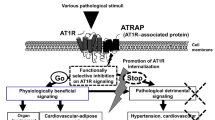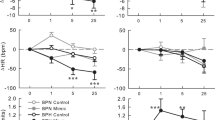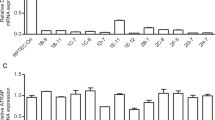Abstract
Angiotensin II type 1 receptor (AT1R) is a vital therapeutic target for hypertension. Sorting nexin 1 (SNX1) participates in the sorting and trafficking of the renal dopamine D5 receptor, while angiotensin and dopamine are counterregulatory factors in the regulation of blood pressure. The effect of SNX1 on AT1R is not known. We hypothesized that SNX1, through arterial AT1R sorting and trafficking, is involved in blood pressure regulation. CRISPR/Cas9 system-generated SNX1−/− mice showed dramatic elevations in blood pressure compared to their wild-type littermates. The angiotensin II-mediated contractile reactivity of the mesenteric arteries and AT1R expression in the aortas were also increased. Moreover, immunofluorescence and immunoprecipitation analyses revealed that SNX1 and AT1R were colocalized and interacted in the aortas of wild-type mice. In vitro studies revealed that AT1R protein levels and downstream calcium signaling were upregulated in A10 cells treated with SNX1 siRNA. This may have resulted from decreased AT1R protein degradation since the AT1R mRNA levels showed no changes. AT1R protein was less degraded when SNX1 was downregulated, as reflected by a cycloheximide chase assay. Furthermore, proteasomal rather than lysosomal inhibition increased AT1R protein content, and this effect was accompanied by decayed binding of ubiquitin and AT1R after SNX1 knockdown. Confocal microscopy revealed that AT1R colocalized with PSMD6, a proteasomal marker, and the colocalization was reduced after SNX1 knockdown. These findings suggest that SNX1 sorts AT1R for proteasomal degradation and that SNX1 impairment increases arterial AT1R expression, leading to increased vasoconstriction and blood pressure.
This is a preview of subscription content, access via your institution
Access options
Subscribe to this journal
Receive 12 print issues and online access
$259.00 per year
only $21.58 per issue
Buy this article
- Purchase on Springer Link
- Instant access to full article PDF
Prices may be subject to local taxes which are calculated during checkout






Similar content being viewed by others
References
Zhou B, Danaei G, Stevens GA, Bixby H, Taddei C, Carrillo-Larco RM, et al. Long- term and recent trends in hypertension awareness, treatment, and control in 12 high- income countries: an analysis of 123 nationally representative surveys. Lancet. 2019;394:639–51.
Ettehad D, Emdin CA, Kiran A, Anderson SG, Callender T, Emberson J, et al. Blood pressure lowering for prevention of cardiovascular disease and death: a systematic review and meta-analysis. Lancet. 2016;387:957–67.
Forouzanfar MH, Liu P, Roth GA, Ng M, Biryukov S, Marczak L, et al. Global burden of hypertension and systolic blood pressure of at least 110 to 115 mm Hg, 1990-2015. JAMA. 2017;317:165–82.
Bohr DF, Dominiczak A, Webb RC. Pathophysiology of the vasculature in hypertension. Hypertension. 1991;18:III69.
Brown IAM, Diederich L, Good ME, DeLalio LJ, Murphy SA, Cortese-Krott MM, et al. Vascular smooth muscle remodeling in conductive and resistance arteries in hypertension. Arterioscler Thromb Vasc Biol. 2018;38:1969–85.
Laurent S, Boutouyrie P. The structural factor of hypertension: large and small artery alterations. Circ Res. 2015;116:1007–21.
Chen K, Fu C, Chen C, Liu L, Ren H, Han Y, et al. Role of GRK4 in the regulation of arterial AT1 receptor in hypertension. Hypertension. 2014;63:289–96.
Wang Z, Zeng C, Villar VAM, Chen S-Y, Konkalmatt P, Wang X, et al. Human GRK4γ 142V variant promotes angiotensin II type I receptor–mediated hypertension via renal histone deacetylase type 1 inhibition. Hypertension. 2016;67:325–34.
Wynne BM, Chiao C-W, Webb RC. Vascular smooth muscle cell signaling mechanisms for contraction to angiotensin II and endothelin-1. J Am Soc Hypertens. 2009;3:84–95.
Nickenig G, Harrison DG. The AT1-type angiotensin receptor in oxidative stress and atherogenesis: part I: oxidative stress and atherogenesis. Circulation. 2002;105:393–6.
Vaziri ND, Bai Y, Ni Z, Quiroz Y, Pandian R, Rodriguez-Iturbe B. Intra-renal angiotensin II/AT1 receptor, oxidative stress, inflammation, and progressive injury in renal mass reduction. J Pharm Exp Ther. 2007;323:85–93.
Sanz-Rosa D, Oubina MP, Cediel E, de las Heras N, Vegazo O, Jiménez J, et al. Effect of AT1 receptor antagonism on vascular and circulating inflammatory mediators in SHR: role of NF-κB/IκB system. Am J Physiol-Heart Circulatory Physiol. 2005;288:H111–5.
Smith GR, Missailidis S. Cancer, inflammation and the AT1 and AT2 receptors. J Inflamm. 2004;1:3.
Williams B. Angiotensin II and the pathophysiology of cardiovascular remodeling. Am J Cardiol. 2001;87:10–17.
Takemoto M, Egashira K, Tomita H, Usui M, Okamoto H, Kitabatake A, et al. Chronic angiotensin-converting enzyme inhibition and angiotensin II type 1 receptor blockade: effects on cardiovascular remodeling in rats induced by the long-term blockade of nitric oxide synthesis. Hypertension. 1997;30:1621–7.
Yang J, Van Anthony MV, Rozyyev S, Jose PA, Zeng C. The emerging role of sorting nexins in cardiovascular diseases. Clin Sci. 2019;133:723–37.
Zhang H, Huang T, Hong Y, Yang W, Zhang X, Luo H, et al. The retromer complex and sorting nexins in neurodegenerative diseases. Front aging Neurosci. 2018;10:79.
Teasdale RD, Collins BM. Insights into the PX (phox-homology) domain and SNX (sorting nexin) protein families: structures, functions and roles in disease. Biochem J. 2012;441:39–59.
Worby CA, Dixon JE. Sorting out the cellular functions of sorting nexins. Nat Rev Mol Cell Biol. 2002;3:919.
Van Anthony MV, Jones JE, Armando I, Asico LD, Escano CS, Lee H, et al. Sorting nexin 1 loss results in D5 dopamine receptor dysfunction in human renal proximal tubule cells and hypertension in mice. J Biol Chem. 2013;288:152–63.
Villar VAM, Armando I, Sanada H, Frazer LC, Russo CM, Notario PM, et al. Novel role of sorting nexin 5 in renal D1 dopamine receptor trafficking and function: implications for hypertension. FASEB J. 2013;27:1808–19.
Li F, Yang J, Jones JE, Villar VAM, Yu P, Armando I, et al. Sorting nexin 5 and dopamine D1 receptor regulate the expression of the insulin receptor in human renal proximal tubule cells. Endocrinology. 2015;156:2211–21.
Drake MT, Shenoy SK, Lefkowitz RJ. Trafficking of G protein–coupled receptors. Circ Res. 2006;99:570–82.
Carlton J, Bujny M, Peter BJ, Oorschot VM, Rutherford A, Mellor H, et al. Sorting nexin-1 mediates tubular endosome-to-TGN transport through coincidence sensing of high-curvature membranes and 3-phosphoinositides. Curr Biol. 2004;14:1791–1800.
Zeng C, Jose PA. Dopamine receptors: important antihypertensive counterbalance against hypertensive factors. Hypertension. 2011;57:11–17.
Gildea JJ. Dopamine and angiotensin as renal counter regulatory systems controlling sodium balance. Curr Opin Nephrol Hypertens. 2009;18:28.
Xiao J, Liu J, Lio I, Yang C, Chen X, Zhang H, et al. All-trans retinoic acid attenuates the progression of Ang II-induced abdominal aortic aneurysms in ApoE−/−mice. J Cardiothorac Surg. 2020;15:1–9.
Lin P, Wu M, Qin J, Yang J, Ye C, Wang C. Magnesium lithospermate B improves renal hemodynamics and reduces renal oxygen consumption in 5/6th renal ablation/infarction rats. BMC Nephrol. 2019;20:49.
Cheng Z, Zhang M, Hu J, Lin J, Feng X, Wang S, et al. Cardiac specific Mst1 deficiency inhibits ROS mediated JNK signalling to alleviate Ang II induced cardiomyocyte apoptosis. J Cell Mol Med. 2019;23:543–55.
Mulvany MJ, Halpern W. Contractile properties of small arterial resistance vessels in spontaneously hypertensive and normotensive rats. Circ Res. 1977;41:19–26.
Yao Y, Wang W, Li M, Ren H, Chen C, Wang J, et al. Curcumin exerts its anti-hypertensive effect by down-regulating the AT 1 receptor in vascular smooth muscle cells. Sci Rep. 2016;6:25579.
Fu J, Han Y, Wang J, Liu Y, Zheng S, Zhou L, et al. Irisin lowers blood pressure by improvement of endothelial dysfunction via AMPK Akt eNOS NO pathway in the spontaneously hypertensive Rat. J Am Heart Assoc. 2016;5:e003433.
Fu J, Han Y, Wang H, Wang Z, Liu Y, Chen X, et al. Impaired dopamine D 1 receptor- mediated vasorelaxation of mesenteric arteries in obese Zucker rats. Cardiovasc Diabetol. 2014;13:50.
Wu LP, Gong ZF, Wang H, Zhou ZS, Zhang MM, Liu C, et al. TSPO ligands prevent the proliferation of vascular smooth muscle cells and attenuate neointima formation through AMPK activation. Acta Pharm Sin. 2020;41:34–46.
Xu H, Zhang H, Liu G, Kong L, Zhu X, Tian X, et al. Coumarin-based fluorescent probes for super-resolution and dynamic tracking of lipid droplets. Anal Chem. 2019;91:977–82.
Bigarella CL, Borges L, Costa FF, Saad ST. ARHGAP21 modulates FAK activity and impairs glioblastoma cell migration. Biochim Biophys Acta. 2009;1793:806–16.
Han JM, Jeong SJ, Park MC, Kim G, Kwon NH, Kim HK, et al. Leucyl-tRNA synthetase is an intracellular leucine sensor for the mTORC1-signaling pathway. Cell. 2012;149:410–24.
Liu C, Hu YH, Han Y, Wang YB, Zhang Y, Zhang XQ, et al. MG53 protects against contrast-induced acute kidney injury by reducing cell membrane damage and apoptosis. Acta Pharmacol Sin. 2020. https://doi.org/10.1038/s41401-020-0420-8.
Liu C, Chen K, Wang H, Zhang Y, Duan X, Wang H, et al. Gastrin attenuates renal ischemia/reperfusion injury by a PI3K/Akt/Bad-mediated anti-apoptosis signaling. Front Pharmacol. 2020;11:1672.
Gavet O, Pines J. Progressive activation of CyclinB1-Cdk1 coordinates entry to mitosis. Dev Cell. 2010;18:533–43.
Jin SW, Choi CY, Hwang YP, Kim HG, Kim SJ, Chung YC, et al. Betulinic acid increases eNOS phosphorylation and no synthesis via the calcium-signaling pathway. J Agric Food Chem. 2016;64:785–91.
Li H, Armando I, Yu P, Escano C, Mueller SC, Asico L, et al. Dopamine 5 receptor mediates Ang II type 1 receptor degradation via a ubiquitin-proteasome pathway in mice and human cells. J Clin Investig. 2008;118:2180–9.
Do KH, Kim MS, Kim JH, Rhim B-Y, Lee WS, Kim CD, et al. Angiotensin II-induced aortic ring constriction is mediated by phosphatidylinositol 3-kinase/L-type calcium channel signaling pathway. Exp Mol Med. 2009;41:569.
Wang X, Zhao Y, Zhang X, Badie H, Zhou Y, Mu Y, et al. Loss of sorting nexin 27 contributes to excitatory synaptic dysfunction by modulating glutamate receptor recycling in Down’s syndrome. Nat Med. 2013;19:473.
Mangieri LR, Mader BJ, Thomas CE, Taylor CA, Luker AM, Tse TE, et al. ATP6V0C knockdown in neuroblastoma cells alters autophagy-lysosome pathway function and metabolism of proteins that accumulate in neurodegenerative disease. PLoS ONE. 2014;9:e93257.
Gildea JJ, Wang X, Jose PA, Felder RA. Differential D1 and D5 receptor regulation and degradation of the angiotensin type 1 receptor. Hypertension. 2008;51:360–6.
Kurten RC, Cadena DL, Gill GN. Enhanced degradation of EGF receptors by a sorting nexin, SNX1. Science. 1996;272:1008–10.
Kurten RC, Eddington AD, Chowdhury P, Smith RD, Davidson AD, Shank BB. Self- assembly and binding of a sorting nexin to sorting endosomes. J Cell Sci. 2001;114:1743–56.
Yang J, Asico LD, Beitelshees AL, Feranil JB, Wang X, Jones JE, et al. Sorting nexin 1 loss results in increased oxidative stress and hypertension. FASEB J. 2020. https://doi.org/10.1096/fj.201902448R.
Wilde E, Aubdool AA, Thakore P, Baldissera L Jr, Alawi KM, Keeble J, et al. Tail-cuff technique and its influence on central blood pressure in the mouse. J Am Heart Assoc. 2017;6:e005204.
Arun K, Kaul C, Ramarao P. High glucose concentration augments angiotensin II mediated contraction via AT1 receptors in rat thoracic aorta. Pharm Res. 2004;50:561–8.
Navar LG, Harrison-Bernard LM, Imig JD, Wang C-T, Cervenka L, Mitchell KD. Intrarenal angiotensin II generation and renal effects of AT1 receptor blockade. J Am Soc Nephrology. 1999;10:S266–72.
Qadri F, Culman J, Veltmar A, Maas K, Rascher W, Unger T. Angiotensin II-induced vasopressin release is mediated through alpha-1 adrenoceptors and angiotensin II AT1 receptors in the supraoptic nucleus. J Pharm Exp Ther. 1993;267:567–74.
Zheng H, Li Y-F, Wang W, Patel KP. Enhanced angiotensin-mediated excitation of renal sympathetic nerve activity within the paraventricular nucleus of anesthetized rats with heart failure. Am J Physiol Regul Integr Comp Physiol. 2009;297:R1364–74.
Zhang Z, Li M, Lu R, Alioua A, Stefani E, Toro L. The angiotensin II type 1 receptor (AT1R) closely interacts with large conductance voltage- and Ca2+-activated K+ (BK) channels and inhibits their activity independent of G-protein activation. J Biol Chem. 2014;289:25678–89.
Kao SH, Wang WL, Chen CY, Chang YL, Wu YY, Wang YT, et al. Analysis of protein stability by the cycloheximide chase assay. Bio Protoc. 2015;5:e1374.
Buchanan BW, Lloyd ME, Engle SM, Rubenstein EM. Cycloheximide chase analysis of protein degradation in Saccharomyces cerevisiae. J Vis Exp. 2016. https://doi.org/10.3791/53975.
Comeau JW, Costantino S, Wiseman PW. A guide to accurate fluorescence microscopy colocalization measurements. Biophys J. 2006;91:4611–22.
Shulei W, Arena ET, Eliceiri KW, Ming Y. Automated and robust quantification of colocalization in dual-color fluorescence microscopy: a nonparametric statistical approach. IEEE Trans Image Process. 2018;27:622–36.
Bolte S, Cordelières FP. A guided tour into subcellular colocalization analysis in light microscopy. J Microsc. 2006;224:213–32.
Wang X, Robbins J. Proteasomal and lysosomal protein degradation and heart disease. J Mol Cell Cardiol. 2014;71:16–24.
Ciechanover A. The ubiquitin-proteasome proteolytic pathway. Cell. 1994;79:13–21.
Hanyaloglu AC, Zastrow MV. Regulation of GPCRs by endocytic membrane trafficking and its potential implications. Annu Rev Pharm Toxicol. 2008;48:537–68.
Wojcikiewicz RJ. Regulated ubiquitination of proteins in GPCR-initiated signaling pathways. Trends Pharm Sci. 2004;25:35–41.
Wang Y, Zhou Y, Szabo K, Haft CR, Trejo J. Down-regulation of protease-activated receptor-1 is regulated by sorting nexin 1. Mol Biol Cell. 2002;13:1965–76.
Acknowledgements
This study was supported in part by grants from the National Natural Science Foundation of China (31730043, 81570379), the National Key R&D Program of China (2018YFC1312700), the Program of Innovative Research Team by the National Natural Science Foundation (81721001), the Program for Changjiang Scholars and Innovative Research Team in University (IRT1216), The Third Affiliated Hospital of Chongqing Medical University (KY19024), and the National Institutes of Health (R01-DK039308, P01-HL074940).
Author information
Authors and Affiliations
Corresponding authors
Ethics declarations
Conflict of interest
The authors declare no competing interests.
Additional information
Publisher’s note Springer Nature remains neutral with regard to jurisdictional claims in published maps and institutional affiliations.
Supplementary information
Rights and permissions
About this article
Cite this article
Liu, C., Li, X., Fu, J. et al. Increased AT1 receptor expression mediates vasoconstriction leading to hypertension in Snx1−/− mice. Hypertens Res 44, 906–917 (2021). https://doi.org/10.1038/s41440-021-00661-x
Received:
Revised:
Accepted:
Published:
Issue Date:
DOI: https://doi.org/10.1038/s41440-021-00661-x
Keywords
This article is cited by
-
Update on Hypertension Research in 2021
Hypertension Research (2022)
-
ATRAP, a receptor-interacting modulator of kidney physiology, as a novel player in blood pressure and beyond
Hypertension Research (2022)
-
New insight into increased angiotensin II type 1 receptor expression in Snx1−/− mice
Hypertension Research (2021)
-
Aerobic training-mediated DNA hypermethylation of Agtr1a and Mas1 genes ameliorate mesenteric arterial function in spontaneously hypertensive rats
Molecular Biology Reports (2021)



